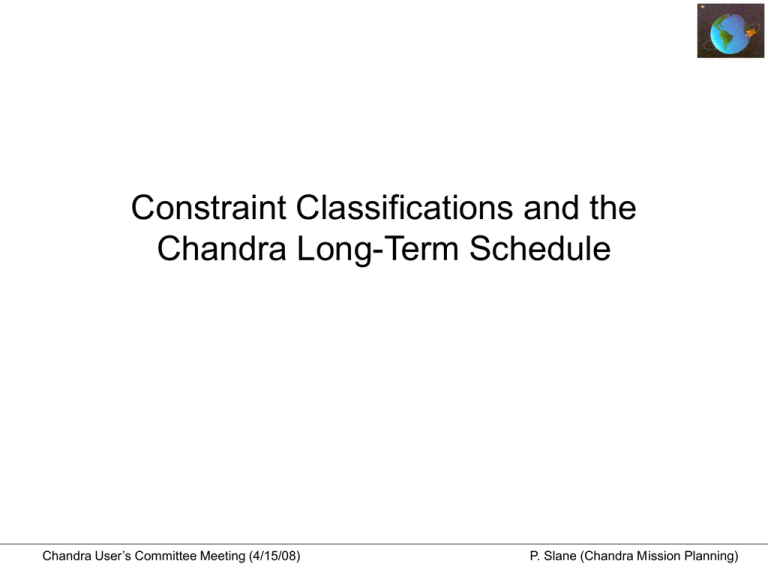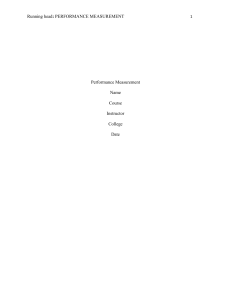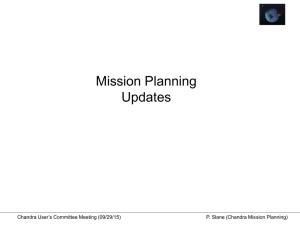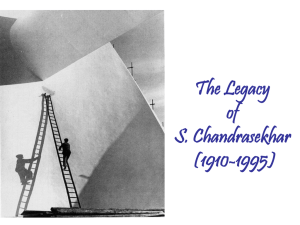Constraint Classifications and the Chandra Long-Term Schedule
advertisement

Constraint Classifications and the Chandra Long-Term Schedule Chandra User’s Committee Meeting (4/15/08) P. Slane (Chandra Mission Planning) Fuel lines throughout this area EPHIN Chandra Spacecraft +X +Y +Z Chandra User’s Committee Meeting (4/15/08) P. Slane (Chandra Mission Planning) Chandra Observing Constraints Angle range Restriction 0-46 No observations 46-56 Observations with 6 ACIS chips may be limited to ∼ 35 ks 56-60 unrestricted 60-135 Observations limited to ∼ 10 ks to substantial fraction of full orbit, depending on pitch of current observation and pitch history 135-152 Unrestricted 152-170 ∼ 7 to 25 ks duration, depending on length of previous observations at low pitch angle 170-180 No observations Hot Reason HRMA Sun aviodance ACIS PSMC temperature EPHIN temperature limitations Propulsion line temperature limitations Propulsion line temperature limitations Good Good Cold Chandra User’s Committee Meeting (4/15/08) P. Slane (Chandra Mission Planning) Limits on Constrained Observations • New limitations on observer-constraints were derived in order to differentiate between easy and difficult constraints • The overall metric is related to the amount of available time to meet a constraint (2) Metric for monitoring is (initial interval)*(fractional tolerance)/(total duration of single observations) (3) Metric for groups is (time interval for group)/(total observing time in group) Chandra User’s Committee Meeting (4/15/08) P. Slane (Chandra Mission Planning) Breakdown of Approved Constraints Quantity Observations Total 885 CAL 100 Constrained Observations Roll Constraints Window Constraints Uninterrupt Constraints Monitor Constraints Phase Constraints Group Constraints Coordinated Observations 186* 41 63 113 112 8 9(85) 38 100 0 44 100 58 0 4(58) 1 *+20 from joint proposals with HST/Spitzer/XMM • A total of about 11% of non-CAL observations have constraints - this is similar to limits in earlier (but post-EPHIN-heating) years • All constrained observations were placed successfully in LTS - a couple had to be modified because the constraints were impossible as specified • Most preferences also placed successfully in LTS - those that required significant time at bad pitch, but could otherwise be done at cold attitudes, were not met - note that some preferences may not be met if LTS updates are required (e.g. for TOO/DDT observations or thermal issues with constrained observations) Chandra User’s Committee Meeting (4/15/08) P. Slane (Chandra Mission Planning) Difficult Constrained Observations 6 pointings, 29 ks each: Window Constraint: :window-constr-start-1 :window-constr-start-2 :window-constr-start-3 :window-constr-start-4 2008:122:00:00:00 2008:143:00:00:00 2008:171:00:00:00 2008:198:00:00:00 :window-constr-stop-1 :window-constr-stop-2 :window-constr-stop-3 :window-constr-stop-4 2008:141:00:00:00 2008:168:00:00:00 2008:195:00:00:00 2008:214:00:00:00 Phase Constraint: :phase-epoch 2008:122:03:50:24 :phase-period 000:23:56:04.128 :phase-start 0.000000 :phase-start-margin 0.020000 :phase-end 0.334000 :phase-end-margin 0.020000 Uninterrupt Constraint: :seg-max-nbr 1 Monitor Constraint: :pre-min-lead 000:00:00:00.000 :pre-max-lead 009:00:00:00.000 Issues: • Phase constraint designed to provide coordinated observations w/ ground-based telescope • Phase constraint + Monitor constraint impossible due to radiation zones • Window 1 is in PLine; Window 2 is in PLine/PropLine Solution: • PI relaxed constraints until this was feasible Chandra User’s Committee Meeting (4/15/08) P. Slane (Chandra Mission Planning) Difficult Unconstrained Observations Carina Region • Almost always at bad EPHIN pitch • 1.2 Ms approved over three different Carina regions • We get ~20-30 ks of “free” hot time per orbit by cooling in radiation zones - beyond this, we need cold targets to balance EPHIN temperatures - Carina observations use up ~29-44% of this “free” hot time Chandra User’s Committee Meeting (4/15/08) Galactic Center Region • At good pitch for about 35 days - this corresponds to about 1.8-2 Ms once radiation zones are subtracted • 1.6 Ms approved over four different Galactic Center regions - Combined with other targets at good pitch in same time window, some observations forced to be carried out at bad pitch even without observer constraints P. Slane (Chandra Mission Planning) Overall Assessment The impact of the modified constraint rules is hard to evaluate at this point • Difficulty of LTS generation was similar to past several years • A review with the Flight Operations Team was required to evaluate ~6 weeks that appear on the edge of being feasible as planned - at least one week that appeared feasible ended up needing modification (because thermal conditions were worse than we estimated) - we may encounter more such problems as the year progresses • TOO planning has been very tight in some time periods, with very little flexibility in balancing thermal issues, approved constraints, and TOO/DDT requests - for some DDT requests, initial constraints (e.g. monitoring intervals) have required modification in order to allow schedule to satisfy other constraints (but all such modifications were deemed to have negligible science impact before they were approved) • A full assessment of the impact of the new rules will not be possible until we have completed the bulk of the Cycle 9 observations - Note: any such assessment is, like the preliminary assessment presented here, largely subjective since the impact on efficiency is very difficult to assess Chandra User’s Committee Meeting (4/15/08) P. Slane (Chandra Mission Planning)




![[PPT] Constrained Observations](http://s2.studylib.net/store/data/015476891_1-596231c84fcf048dca505175b4679169-300x300.png)